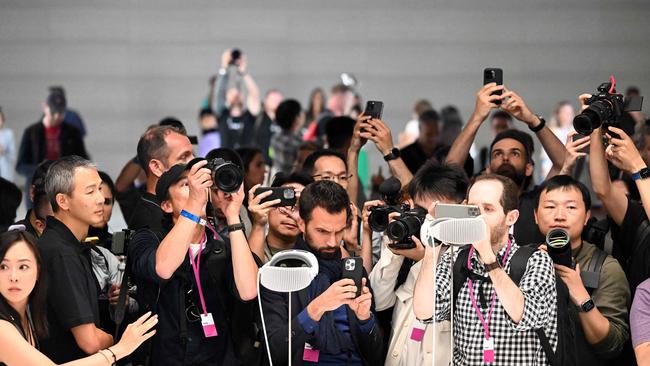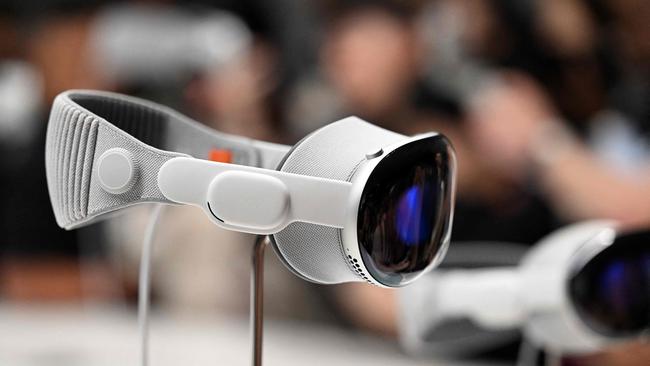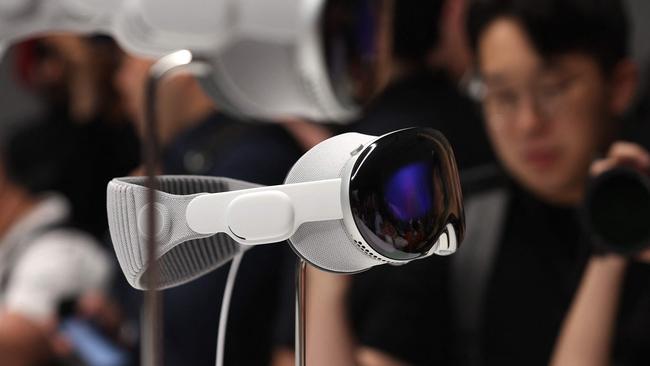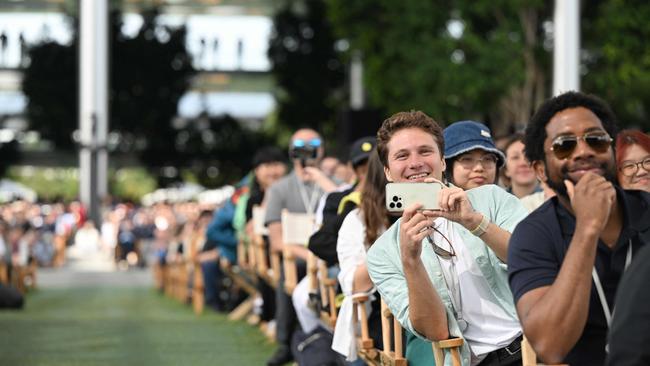Apple Vision Pro is Apple’s first mixed reality ‘spatial computer’ headset
Apple has launch its first-ever mixed reality “spatial computer” headset, the Apple Vision Pro – but it has a hefty price tag.

Gadgets
Don't miss out on the headlines from Gadgets. Followed categories will be added to My News.
Apple has announced the launch of its first-ever mixed reality “spatial computer” headset, the Apple Vision Pro.
It’s a bold move to challenge Facebook-owner Meta in the emerging virtual reality market.
The highly anticipated release marks Apple’s most significant product debut since the unveiling of the Apple Watch in 2015.

During the announcement event, Apple CEO Tim Cook emphasised the groundbreaking potential of blending digital content with the real world.
“Blending digital content with the real world can unlock experiences like nothing we’ve ever seen,” Cook stated as he revealed the Vision Pro, a sleek VR device resembling “ski goggles.”

“Just as the Mac introduced us to personal computing, and iPhone introduced us to mobile computing, Apple Vision Pro introduces us to spatial computing. Built upon decades of Apple innovation, Vision Pro is years ahead and unlike anything created before — with a revolutionary new input system and thousands of groundbreaking innovations.

“It unlocks incredible experiences for our users and exciting new opportunities for our developers.”
With a hefty price tag of AU $5288, the Vision Pro is set to hit the US market early next year, and “other countries” later in the year, according to Apple.
The introduction of the VR headset concluded an Apple event that featured a range of product updates.

Notably, Apple partnered with Disney for the headset launch, garnering excitement from fans. Disney CEO Bob Iger expressed his enthusiasm, stating, “We’re so proud to yet again be partnering the greatest storytelling company in the world with the most innovative technology company in the world to bring you real-life magic.”
Disney teased that streaming content from popular franchises such as Marvel, Star Wars, and live sports would be available on the Vision Pro.
NEWS: Apple has unveiled the VisionPro, the first ground up new product category they’ve introduced in the Tim Cook era. pic.twitter.com/2vXVMGwmGJ
— Sawyer Merritt (@SawyerMerritt) June 5, 2023
🚨BREAKING: Apple Vision PRO / NEW Mixed Reality Headset
— Mario Nawfal (@MarioNawfal) June 5, 2023
Are we witnessing the future of technology? pic.twitter.com/YKj22l46E6
“Apple Vision Pro is a new kind of computer hat seamlessly blends the real world and the digital world†pic.twitter.com/PWIBRiseAS
— Marques Brownlee (@MKBHD) June 5, 2023
Apple Unveiling the New Apple Vision Pro is equivalent to them unveiling the first ever iPhone.. this is honestly insane. IOS 17 #WWDC23pic.twitter.com/qFE94YSSdl
— Qura (@Qurandale) June 5, 2023
Welcome to the era of spatial computing with Apple Vision Pro. You’ve never seen anything like this before! pic.twitter.com/PEIxKNpXBs
— Tim Cook (@tim_cook) June 5, 2023
While the Vision Pro boasts impressive capabilities, it requires substantial computing power and will mainly operate when plugged into a power source, with the battery providing only two hours of usage. Apple acknowledged the gaming audience by announcing that over 100 Apple Arcade games would be available upon the device’s release. Additionally, the headset projects the user’s eyes onto an external screen to facilitate interactions with others.
Apple’s foray into VR comes after years of development on the headset, which will focus on gaming, streaming video, conferencing, as well as health and fitness applications.

Rolf Illenberger, founder and CEO of VRdirect, a virtual reality software company, acknowledged the device’s potential, stating, “It would be drastic to say that Apple Vision Pro will replace a computer or cellphone in the immediate future. But that day will happen soon, most likely starting with those who enjoy having a second or third monitor at their workstations.”
A collision course in reality?
The release of the Vision Pro puts Apple on a collision course with Meta, previously known as Facebook, as the two tech giants vie for dominance in the rapidly evolving VR landscape. Just days prior to Apple’s announcement, Meta unveiled its new-generation Quest 3 VR headgear, set to launch later this year with improved performance and a slimmed design starting at about AU $755.

Meta’s CEO Mark Zuckerberg described the forthcoming model as the company’s “most powerful headset yet” and pledged that it would offer the best wireless experience for VR. While Meta has positioned itself as a frontrunner in the metaverse, its metaverse endeavours have faced setbacks.
Recently, Meta underwent significant restructuring, laying off tens of thousands of employees and redirecting its focus back to core social media operations.
In addition to the Vision Pro, Apple introduced a new 15-inch MacBook Air, catering to users who prioritise a large screen over powerful computing capabilities. The company also unveiled updates to its iPhone operating system, which aimed to catch up with features already available on Android phones or WhatsApp.
What else did Apple announce?
Privacy updates
Apple has also unveiled powerful privacy and security features, including updates to Safari Private Browsing, Communication Safety, and Lockdown Mode.
The enhancements aim to give users more control over their data while prioritising privacy. New features like Check In, NameDrop, and Live Voicemail have also been introduced.
Apple’s says the features, which will begin updates in the US Spring, honour its commitment to privacy as a fundamental right.
Apple Watch OS 10
Apple has announced watchOS 10, a significant update for Apple Watch. The update brings redesigned apps, a new Smart Stack, additional watch faces, new features for cycling and hiking, and tools to support mental health.
The redesigned apps offer more information at a glance and improved navigation.
The Smart Stack provides relevant widgets based on the user’s context, and new watch faces, including Palette and Snoopy, bring artistic and joyful designs.
For cyclists, there are advanced metrics, Workout Views, and Bluetooth connectivity for accessories.

Hikers benefit from Compass Waypoints, Maps with topographic details, and trail information. The Mindfulness app supports mental health by allowing users to log their emotions and moods.
Other updates include features like NameDrop, offline maps, FaceTime video playback, and enhancements to Apple Fitness+. The update also introduces support for Mobile Device Management (MDM) for enterprise customers.
Developers gain access to new APIs for creating workout experiences and analysing motion data. The developer beta of watchOS 10 is available now, and the public beta will be released next month, with the official release scheduled for the US spring.
iOS 17, iPadOS 17, tvOS 17 and macOS Sonoma
Apple has announced iOS 17, a major update that enhances communication features such as Phone, FaceTime, and Messages.
The update includes personalised contact posters for incoming calls, live voicemail transcription, and the ability to share audio and video messages on FaceTime.
Messages receive significant updates, including new sticker experiences and search filters. AirDrop introduces NameDrop for easy contact and content sharing.
Autocorrect and dictation are improved for more intelligent typing, and a new feature called StandBy displays glanceable information while the iPhone is charging.
A new app called Journal helps users practice gratitude through journaling, and there are updates to Safari, Maps, AirTag, Apple Music, Home app, Reminders, and more. Privacy and accessibility features are also enhanced. The developer beta is available now, and the public beta will be available next month, with a free software update coming in the spring for eligible devices.
15‑inch MacBook Air, Mac Studio, Mac Pro and M2 Ultra
Apple has unveiled the new 15-inch MacBook Air, claiming it to be the best laptop of its size. The laptop features a large 15.3-inch Liquid Retina display, the powerful M2 chip, up to 18 hours of battery life, and a six-speaker sound system.

It boasts a thin and lightweight design without a fan. The MacBook Air also includes a 1080p FaceTime HD camera, MagSafe charging, and runs on macOS Ventura.
The laptop is available for order, with shipping starting on June 13th. Additionally, Apple has reduced the starting price of the 13-inch MacBook Air with the M2 chip. The new MacBook Air is designed with sustainability in mind, using recycled materials.
– With AFP
Originally published as Apple Vision Pro is Apple’s first mixed reality ‘spatial computer’ headset




